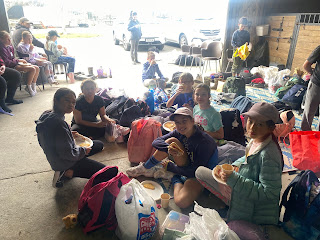PLANTING DAY SUMMARY:
21 Jun 2024 at 581 Clevedon Kawakawa Road, Clevedon
It was such a delightful day of planting with Sunnyhills School. We had wonderful parent
support and the learners were such determined planters. They worked collaboratively
in teams alongiside the parent support and made short work planting 880 plants with
care and attention to detail.
It was a great fit with recent learning around sponge cities and carbon sinks. The new
plants will provide a wonderful habitat whilst increasing biodiversity and improving
water quality. What a wonderful plant signature to leave on the landscape for future
generations to enjoy.
Special thanks to Carol and Chanel in the stable kitchen. Also thanks to Christine for
all of the work supporting the growing of such strong healthy plants and for all of the
background organisation. Thanks to Kirsten for all of the hard work on the planting site
and finishing off the rest of the planting. On site there will be 1006 plants as we used
extras left over from another school planting. Team work truly does make the dream
work.
TfS Facilitator: Kate de Groot Teacher: Christine Daniel
No. of Students: 30 No. of Teachers: 1
No. of Parents, Landowners & Others: 13 Length of waterway planted: 100m
200 x Mānuka
(Leptospermum scoparium)
Manuka is great for restoration projects as it is common through NZ, hardy
and tolerant of a range of habitats from wetlands to dry slopes. It is a good
nursery crop, food source for birds and insects and honey produced from its
flowers has strong antibacterial qualities.
180 x Karamū
(Coprosma robusta)
Common throughout NZ and easily recognized by its bright orange ripe fruit,
This bushy shrub grows to 6m tall and provides food for birds in winter. It
easily self-seeds which makes it a great plant for many restoration projects.
146 x Tī Kōuka
(Cabbage Tree / Cordyline australis)
One of our most iconic native plants. Ti Kouka trees prefer open wet areas
and swamps and their large taproot helps stop soil erosion. Flowers are
enjoyed by insects and birds. It has the fastest growing root system over 5
years than any other species. It belongs to the lily family.
120 x Harakeke
(Flax / Phormium tenax)
Found throughout NZ, flax grows well in a wide range of habitats but
favours wetlands and open riversides. Its flower stalks can grow up to 4m
tall and tui and bellbird are especially fond of the nectar.
20 x Upokotangata
(Giant Umbrella Sedge / Cyperus ustulatus)
Abundant throughout NZ, it grows well in damp open areas like stream
sides or wetlands where it makes great nesting habitat for aquatic birds.
Growing up to 2m tall dark brown seed heads makes it easy to identify.
180 x Pukio
(Carex virgata)
This sedge is widespread in swamps and damp locations in lowland forest
throughout NZ. It can grow to 1m in height and long dropping leaves and
flower spikes.
160 x Purei
(Carex secta / Pukio)
This sedge is widespread in wetlands throughout NZ and grows into distinct
tussocks with a trunk like base. It can grow to 1.5m in height and has long
dropping leaves and flower spikes. It prefers still water and can grow in water.





















%20tfs%20group.jpeg)




























